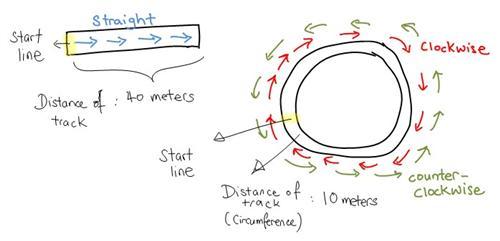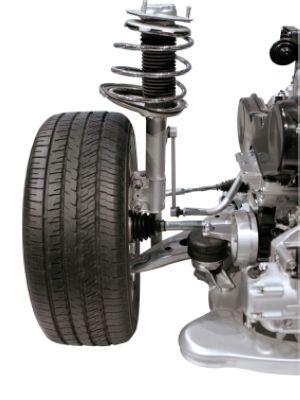| Complexity level: | 4 |
| Project cost ($): | 40 |
| Time required: | 2 hours to prepare the car for experiment, 1 hour to run the experiment. |
| Material availability: | Remote control cars and springs are available from recreational/hobby/toy shops. Some cars run on fuel while others run on batteries. |
| Safety concerns: | Ensure that the cars are run in a safe location. Never do so on an actual road. |
Hypothesis
The firmer the suspension, the faster the car is able to travel around bends.
Overview
How do springs work?
The cornerstone of a car's suspension system is a large coil of spring. In fact, there are four of these, one at each wheel. Springs are found in many objects at home, such as mechanical pencils. A spring is an elastic metal object which is able to store elastic potential energy. A spring stores energy (called potential energy) when it is pulled, without being released. This energy is created as a result of the application of a pulling force on the spring.
A spring can be stretched or compressed. The same mathematics holds for stretching, as for compressing springs. Here, we will primarily discuss energy as it is stored in a spring when it is stretched.
In cars, springs are an integral part of the car's suspension system, which serves to cushion the bumps and the rocking of the car as it moves. This provides for a much more comfortable ride, for the driver and the passengers.
Scientific Terms
Materials
Materials:
- Tamiya customized remote-control sports car (or any other suitable brand for a customizable remote controlled car which runs on a circuit)
- Springs of different levels of firmness, for the remote control car
- Electronic metronome
- Stopwatch
- Blank paper and pen to record the time
- 40 AAA batteries (or batteries that suit the remote control car model)
Procedure
1. For this experiment, the independent variable is the resistance of the spring. The dependent variable is the speed of the car. The constants in this experiment include: the total weight of the remote control car, the type of battery used and the total distance of the race course.
2. The car will run 3 different courses – a straight course, a clockwise course and a counter-clockwise course.
3. All 3 courses should cover the same distance. So, the car will run along the straight course once and 4 times around the circular course, first in a clockwise direction, then in a counter clockwise direction.
4. Start with the springs with the lowest resistance.
a. Install the lowest resistance spring into the car correctly (according to the specified instructions)
b. Ensure the car is fitted with new batteries
5. Set the car at the start line of the straight course.
6. Start the timer and power the car on full throttle. Let the car run the set distance.
7. Stop the timer when the car has finished its course. Record the time taken.
8. Repeat for 2 more time trials.
9. Replace the batteries of the car.
10. Set the car at the start line of the clockwise course.
11. Repeat steps 6 to 9, this time, go 4 laps to cover 40 meters.
12. Set the car at the start line of the counter-clockwise course.
13. Repeat steps 6 to 9, this time, go 4 laps to cover 40 meters.
14. Adjust the remote control to maintain a low speed.
15. Repeat steps 6 to 13, now on low speed.
16. Then, repeat steps 4 to 15 using springs of different resistance.


Results
Record your findings in the following table and find the average time taken to complete the courses:
| Time taken to complete course (Full Speed) in seconds | |||
| Spring stiffness | Straight course | Clockwise Course | Counter-Clockwise Course |
| Stiffest – Trial 1 | 4.03 | 10.07 | 10.51 |
| Stiffest – Trial 2 | 4.04 | 9.93 | 11.19 |
| Stiffest – Trial 3 | 4.1 | 9.93 | 10.83 |
| Average | 4.06 | 9.98 | 10.84 |
| Medium – Trial 1 | 4.28 | 16.73 | 15.27 |
| Medium – Trial 2 | 4.19 | 17.12 | 16.81 |
| Medium – Trial 3 | 4.82 | 16.92 | 15.87 |
| Average | 4.43 | 16.92 | 15.98 |
| Softest – Trial 1 | 4.91 | 10.81 | 13.62 |
| Softest – Trial 2 | 5.71 | 10.16 | 13.93 |
| Softest – Trial 3 | 5.35 | 10.62 | 14.01 |
| Average | 5.32 | 10.53 | 13.85 |
*Create a similar table for the Low Speed records
Conclusion
The results show that the hypothesis should be accepted. Overall, the stiffer the spring, the faster the car travels around bends. However, it is interesting to note that the springs of medium-firmness performed the worst for the round circuit.
This information is useful for understanding the relationship between the stiffness of the spring and the speed of the car. Generally, a stiffer spring provides for a faster car. However, engineers must not take only the suspension into consideration. Engineers and designers must balance speed, safety and aesthetics when designing cars.
Also consider
What other factors affect the speed of the car?
Will using tires of different widths/firmness affect the result of the experiment?
References
http://en.wikipedia.org/wiki/Spring_%28device%29
http://www.suzy.co.nz/suzysworld/Factpage.asp?FactSheet=63

